Micro services or API layer design the most non avoidable design patterns, any product can adopt to evolve into more robust design. It is interesting to look at different patterns from rest or aggregated api with graphql as BFF or server less and working with cloud and Messaging
----------------------------------------------------------------------------------------------------------------------------------------------------------------------------------------------------------------
Monday, April 3, 2023
Why Your Microservices Need GraphQL?
Sunday, April 2, 2023
Top 10 must-know Kubernetes design patterns
Interesting points: Explains how each pattern
focus on key important aspects like Health monitoring and reproting,
distribution of load or even dynamic load balancing depending on the
load.
Patterns
Here are the must-know top 10 design
patterns for beginners synthesized from the
Kubernetes Patterns book. Getting familiar with these patterns will
help you understand foundational Kubernetes concepts, which in turn will help
you in discussions and when designing Kubernetes-based applications.
There are many important concepts in
Kubernetes, but these are the most important ones to start with:
To help you understand, the patterns
are organized into a few categories below, inspired by the Gang of Four's design
patterns.
These patterns represent the
principles and best practices that containerized applications must comply with
in order to become good cloud-native citizens. Regardless of the application's
nature, you should aim to follow these guidelines. Adhering to these principles
will help ensure that your applications are suitable for automation on
Kubernetes.
Health Probe dictates that every container
should implement specific APIs to help the platform observe and manage the
application in the healthiest way possible. To be fully automatable, a
cloud-native application must be highly observable by allowing its state to be
inferred so that Kubernetes can detect whether the application is up and ready
to serve requests. These observations influence the life-cycle management of
Pods and the way traffic is routed to the application.
Predictable Demands explains why every container
should declare its resource profile and stay confined to the indicated resource
requirements. The foundation of successful application deployment, management,
and coexistence on a shared cloud environment is dependent on identifying and
declaring the application's resource requirements and runtime dependencies.
This pattern describes how you should declare application requirements, whether
they are hard runtime dependencies or resource requirements. Declaring your
requirements is essential for Kubernetes to find the right place for your
application within the cluster.
Automated Placement explains how to influence
workload distribution in a multi-node cluster. Placement is the core function
of the Kubernetes scheduler for assigning new Pods to nodes satisfying
container resource requests and honoring scheduling policies. This pattern
describes the principles of Kubernetes’ scheduling algorithm and the way to
influence the placement decisions from the outside.
Having good cloud-native containers
is the first step, but not enough. Reusing containers and combining them into
Pods to achieve the desired outcome is the next step. The patterns in this
category are focused on structuring and organizing containers in a Pod to
satisfy different use cases. The forces that affect containers in Pods result
in these patterns.
Init Container introduces a separate life
cycle for initialization-related tasks and the main application containers.
Init Containers enable separation of concerns by providing a separate life
cycle for initialization-related tasks distinct from the main application containers.
This pattern introduces a fundamental Kubernetes concept that is used in many
other patterns when initialization logic is required.
Sidecar describes how to extend and
enhance the functionality of a pre-existing container without changing it. This
pattern is one of the fundamental container patterns that allows single-purpose
containers to cooperate closely together.
These patterns describe the
life-cycle guarantees of the Pods ensured by the managing platform. Depending
on the type of workload, a Pod might run until completion as a batch job or be
scheduled to run periodically. It might run as a daemon service or singleton.
Picking the right life-cycle management primitive will help you run a Pod with
the desired guarantees.
Batch Job describes how to run an
isolated, atomic unit of work until completion. This pattern is suited for
managing isolated atomic units of work in a distributed environment.
Stateful Service describes how to create and
manage distributed stateful applications with Kubernetes. Such applications
require features such as persistent identity, networking, storage, and
ordinality. The StatefulSet primitive provides these building blocks with
strong guarantees ideal for the management of stateful applications.
Service Discovery explains how clients can
access and discover the instances that are providing application services. For
this purpose, Kubernetes provides multiple mechanisms, depending on whether the
service consumers and producers are located on or off the cluster.
The patterns in this category are
more complex and represent higher-level application management patterns. Some
of the patterns here (such as Controller) are timeless, and Kubernetes itself
is built on top of them.
Controller is a pattern that actively
monitors and maintains a set of Kubernetes resources in a desired state. The
heart of Kubernetes itself consists of a fleet of controllers that regularly
watch and reconcile the current state of applications with the declared target
state. This pattern describes how to leverage this core concept for extending
the platform for our own applications.
An Operator is a Controller that uses a
CustomResourceDefinitions to encapsulate operational knowledge for a specific
application in an algorithmic and automated form. The Operator pattern allows
us to extend the Controller pattern for more flexibility and greater
expressiveness. There are an increasing number of Operators for
Kubernetes, and this pattern is turning into the major form of operating
complex distributed systems.
Today, Kubernetes is the most popular
container orchestration platform. It is jointly developed and supported by all
major software companies and offered as a service by all of the major cloud
providers. Kubernetes supports both Linux and Windows systems, plus all major
programming languages. This platform can also orchestrate and automate
stateless and stateful applications, batch jobs, periodic tasks, and serverless
workloads. The patterns described here are the most commonly used ones from a
broader set of patterns that come with Kubernetes as shown below.

Kubernetes Patters
organized in different categories
Kubernetes is the new application
portability layer and the common denominator among everybody on the cloud. If
you are a software developer or architect, the odds are that Kubernetes will
become part of your life in one form or another. Learning about the Kubernetes
patterns described here will change the way you think about this platform. I
believe that Kubernetes and the concepts originating from it will become as
fundamental as object-oriented programming concepts.
The patterns here are an attempt to
create the Gang of Four design patterns, but for container orchestration.
Reading this article must not be the end, but the beginning of your Kubernetes
journey. Happy kubectl-ing!
GraphQL based solution architecture patterns
Introduction
GraphQL is becoming popular in the tech industry as a replacement for REST. It really carries out significant advantages over existing mechanisms for the client-server type of communications. In simple terms, GraphQL allows the client to choose which information it wants rather than receiving all the data which is available for the API. This is similar to a database query where we request only the required information. That is why it is called as GraphQL. We can do this easily with databases and data services runtime. But if you think about implementing the same capability for a REST API, you have to create so many different resources and the client has to call each and every one of these resources and handle the orchestration logic at the client-side. Otherwise, the API server has to do the heavy-lifting of orchestration. But this is not scalable with the changing demands from customers and the business. You can find a simple example and an explanation of why GraphQL is considered as the better REST by reading the content in the below link.
https://www.howtographql.com/basics/1-graphql-is-the-better-rest
The intention of this post is to discuss possible solution architecture patterns that can be used to implement systems with GraphQL.
Solution Architecture Patterns
Pattern 1 — GraphQL Server exposing database
This is the fundamental use case of the GraphQL. That is to expose a database in a much more controlled manner with additional capabilities like caching. A similar kind of functionality can be achieved with the OData specification. But GraphQL has really excelled beyond the OData by giving users to do basic CRUD operations as well as allowing the consumers to subscribe to data changes. It has clearly separated out the read operations (Queries) from the write operation (Mutations) and introduced a new operation type for data change notifications through Subscriptions.
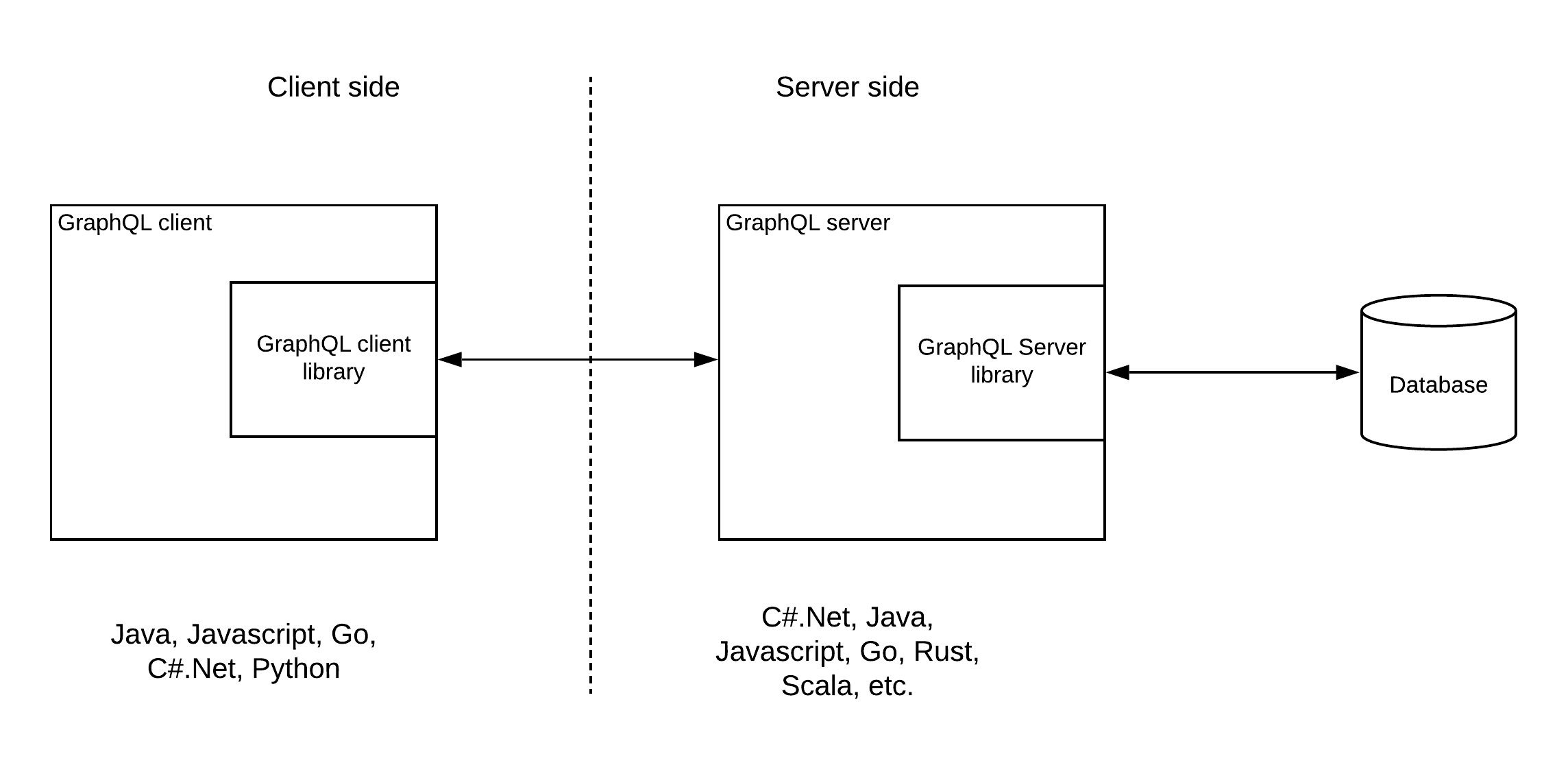 Pattern 1 — GraphQL server exposing a database
Pattern 1 — GraphQL server exposing a database
As depicted in the above figure, GraphQL provides server libraries for multiple programming languages so that developers can build servers based on GraphQL specification. You can find more details on available language support for the server-side from here. Similarly, it provides client libraries to implement GraphQL clients. More details can be found here. GraphQL server exposes a simple HTTP/REST interface so that users can use any existing tools and clients which they have already built.
Pattern 2 — GraphQL as a layer of integration
The real power of the GraphQL specification comes from the ability to provide access to various data sources from the clients in one go. Instead of sending multiple requests (and hence wasting the bandwidth due to headers), GraphQL client can send a single request and get all the data it requires regardless of the actual backend data source. This allows the GraphQL server to act as an integration hub while exposing the services through GraphQL.
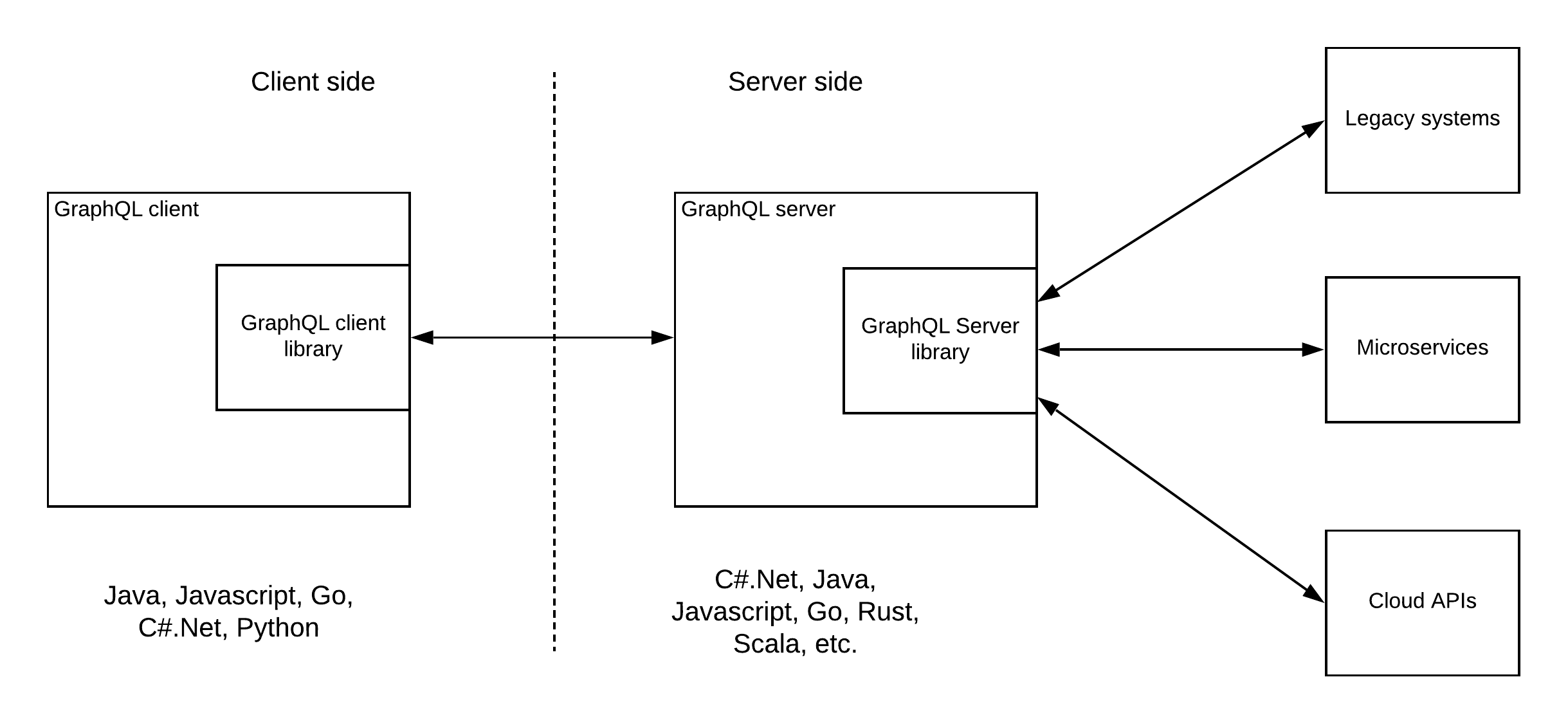 Pattern 2 — GraphQL server as an integration hub As shown in the above figure, GQL server can connect to multiple backend systems within the enterprise including legacy systems, microservices, and existing 3rd party cloud APIs as data sources and provide a unified GraphQL interface to the clients.
Pattern 2 — GraphQL server as an integration hub As shown in the above figure, GQL server can connect to multiple backend systems within the enterprise including legacy systems, microservices, and existing 3rd party cloud APIs as data sources and provide a unified GraphQL interface to the clients.
Pattern 3 — GraphQL hybrid integration
In most of the real-world scenarios, you find there are various systems that need to be connected including databases, legacy apps, microservices, cloud APIs, etc. Therefore, building a GraphQL server that connects to a database as well as other systems can be a more frequent requirement.
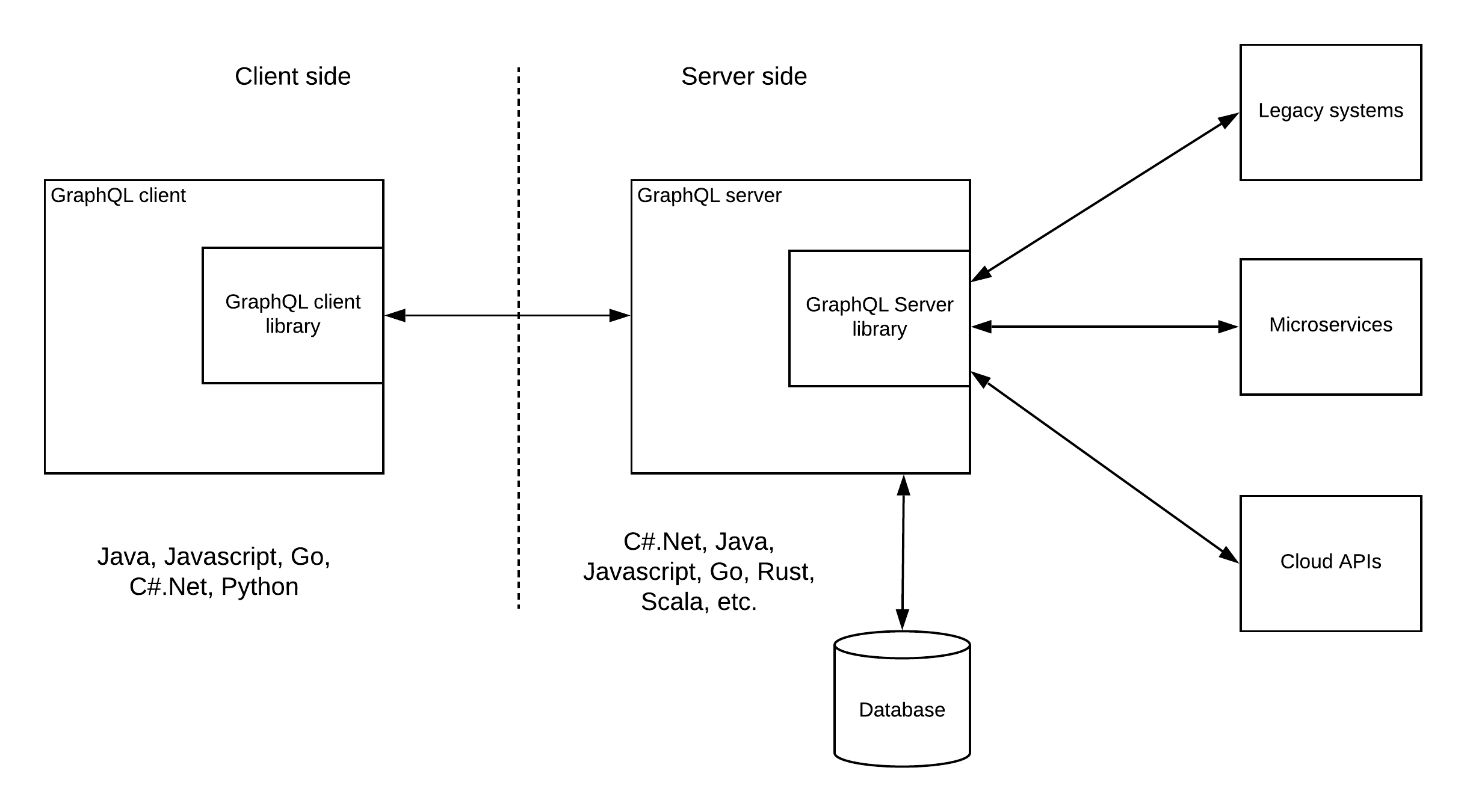 Pattern 3 — GraphQL hybrid integration In this pattern, GraphQL server has its own connected database and it will also connect to external systems. The clients get a unified API that they can consume efficiently without sending multiple requests to get desired data. The above 3 patterns are the standard GraphQL patterns recommended by the GraphQL community. But these patterns don’t fulfill the requirements of a modern enterprise architecture. The interfaces that expose these services need to be managed through a management layer. That is where the API gateways come into the picture.
Pattern 3 — GraphQL hybrid integration In this pattern, GraphQL server has its own connected database and it will also connect to external systems. The clients get a unified API that they can consume efficiently without sending multiple requests to get desired data. The above 3 patterns are the standard GraphQL patterns recommended by the GraphQL community. But these patterns don’t fulfill the requirements of a modern enterprise architecture. The interfaces that expose these services need to be managed through a management layer. That is where the API gateways come into the picture.
Pattern 4 — GraphQL server with one managed API
Exposing the GraphQL based interfaces without any security can be a big issue in most of the enterprise deployments. That is the reason why we need to apply proper protection to these APIs using an API gateway. GraphQL provides a single endpoint to access data and execute various actions on top of that data. Therefore, the simplest approach to protect and manage this interface is by applying the management functionalities over this single endpoint.
 Pattern 4 — GraphQL server with one managed API In this architecture, API gateway provides the security, throttling and monitoring capabilities to the single endpoint which is exposed from the GQL server. If you have multiple GraphQL endpoints available, these endpoints can be protected as separate APIs. Also, with this approach, multiple resources can be implemented for the same API with different throttling and security policies. But this needs to be done as a custom implementation and a lot of manual work needs to be done.
Pattern 4 — GraphQL server with one managed API In this architecture, API gateway provides the security, throttling and monitoring capabilities to the single endpoint which is exposed from the GQL server. If you have multiple GraphQL endpoints available, these endpoints can be protected as separate APIs. Also, with this approach, multiple resources can be implemented for the same API with different throttling and security policies. But this needs to be done as a custom implementation and a lot of manual work needs to be done.
Pattern 5 — GraphQL server with native API management
One of the drawbacks of the above pattern 4 was that GraphQL native concepts (Queries, Mutations, Subscriptions) cannot be managed as separate entities. That is the exact requirement covered with this pattern. Here, once the GraphQL endpoint is provided to the API gateway, it will generate the GraphQL specific endpoints (operations) based on the definition of the GQL file and allow the users to apply throttling, security, and monitoring at these operations level.
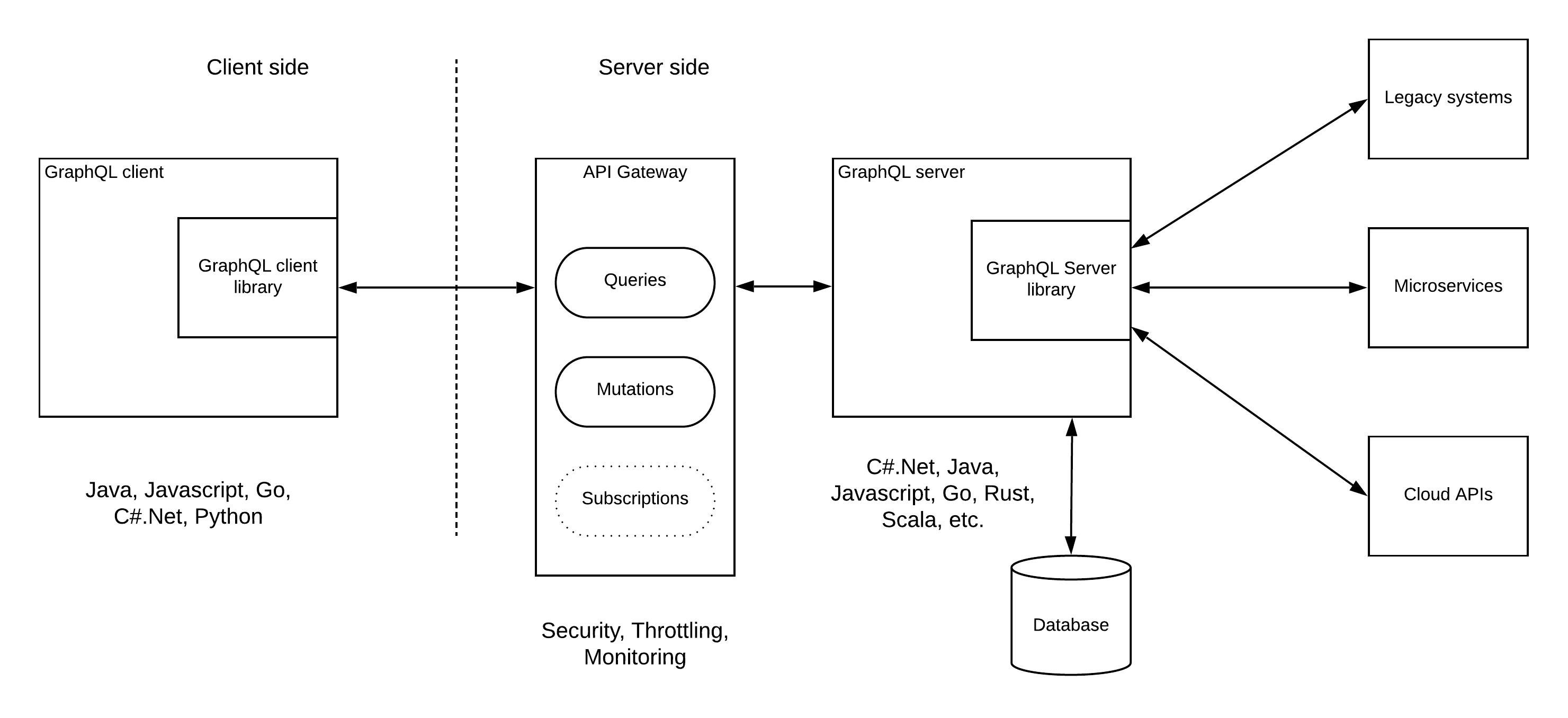 Pattern 5 — GraphQL server with native API management In this pattern, both Queries and Mutations can be implemented with native API management capabilities like security, throttling, caching, monitoring, etc. But the subscription feature of the GQL server cannot be implemented with that functionality since it works in an asynchronous, event-based mechanism.
Pattern 5 — GraphQL server with native API management In this pattern, both Queries and Mutations can be implemented with native API management capabilities like security, throttling, caching, monitoring, etc. But the subscription feature of the GQL server cannot be implemented with that functionality since it works in an asynchronous, event-based mechanism.
Implementation approach
GraphQL servers and clients can be implemented in many different programming languages and there are libraries that are purpose-built for certain technology stacks available in the community. For adding the API management capabilities, users can use existing API management tools like WSO2 API Manager which supports both the above-mentioned pattern 4 as well as pattern 5.
Future
I have discussed some of the possible solution architecture patterns with the GraphQL specification. These are not the only patterns and there can be more and more patterns evolved with the time. Additionally, the above patterns didn’t cover the container-based, cloud-native architecture patterns since that is too much of a scope for a single article. But the concepts mentioned in this article can be reused when building such architectures as well. This article is more or less a foundation article on building real-world systems with GraphQL specification.
Saturday, February 4, 2023
8 The 7 most important software design patterns
Design Patterns can be incredibly useful if used in the right situations and for the right reasons. They can make a programmer significantly more efficient by allowing them to avoid resolving common problems. They also provide a useful common language to conceptualize repeated problems and solutions when discussing with others or managing code in larger teams.
Design Patterns have become an object of some controversy in the programming world in recent times, largely due to their perceived overuse. Code with too many different design patterns is difficult to read or debug.
The best way to avoid problems with design patterns is to learn how and why to use each pattern.
To help you, let’s explore the top 7 design patterns:
Master dozens of the best design patterns.
Learn a design pattern to solve every situation and interview question.
Software Design Patterns: Best Practices for Software Developers
Singleton
The singleton pattern is used to limit creation of a class to only one object. This is beneficial when one (and only one) object is needed to coordinate actions across the system. There are several examples of where only a single instance of a class should exist, including caches, thread pools, and registries.
It’s trivial to initiate an object of a class — but how do we ensure that only one object ever gets created? The answer is to make the constructor ‘private’ to the class we intend to define as a singleton. That way, only the members of the class can access the private constructor and no one else.
Important consideration: It’s possible to subclass a singleton by making the constructor protected instead of private. This might be suitable under some circumstances. One approach taken in these scenarios is to create a register of singletons of the subclasses and the getInstance method can take in a parameter or use an environment variable to return the desired singleton. The registry then maintains a mapping of string names to singleton objects, which can be accessed as needed.

Usually, object creation in Java takes place like so:
`SomeClass someClassObject = new SomeClass();`
The problem with the above approach is that the code using the SomeClass’s object, suddenly now becomes dependent on the concrete implementation of SomeClass.
There’s nothing wrong with using new to create objects but it comes with the baggage of tightly coupling our code to the concrete implementation class, which can occasionally be problematic.
Strategy
The strategy pattern allows grouping related algorithms under an abstraction, which allows switching out one algorithm or policy for another without modifying the client.
Instead of directly implementing a single algorithm, the code receives runtime instructions specifying which of the group of algorithms to run.
Observer
This pattern is a one-to-many dependency between objects so that when one object changes state, all its dependents are notified. This is typically done by calling one of their methods.
For the sake of simplicity, think about what happens when you follow someone on Twitter. You are essentially asking Twitter to send you (the observer) tweet updates of the person (the subject) you followed. The pattern consists of two actors, the observer who is interested in the updates and the subject who generates the updates.
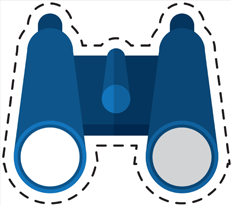
A subject can have many observers and is a one to many relationship. However, an observer is free to subscribe to updates from other subjects too. You can subscribe to news feed from a Facebook page, which would be the subject and whenever the page has a new post, the subscriber would see the new post.
Key consideration: In case of many subjects and few observers, if each subject stores its observers separately, it’ll increase the storage costs as some subjects will be storing the same observer multiple times.
Builder
As the name implies, a builder pattern is used to build objects. Sometimes, the objects we create can be complex, made up of several sub-objects or require an elaborate construction process. The exercise of creating complex types can be simplified by using the builder pattern. A composite or an aggregate object is what a builder generally builds.
Key consideration: The builder pattern might seem similar to the ‘abstract factory’ pattern but one difference is that the builder pattern creates an object step by step whereas the abstract factory pattern returns the object in one go.
Adapter
This allows incompatible classes to work together by converting the interface of one class into another. Think of it as a sort of translator: when two heads of states who don’t speak a common language meet, usually an interpreter sits between the two and translates the conversation, thus enabling communication.
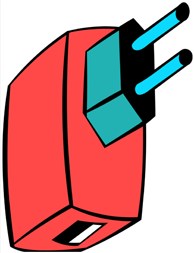
If you have two applications, with one spitting out output as XML with the other requiring JSON input, then you’ll need an adapter between the two to make them work seamlessly.
State
The state pattern encapsulates the various states a machine can be in, and allows an object to alter its behavior when its internal state changes. The machine or the context, as it is called in pattern-speak, can have actions taken on it that propel it into different states.
Without the use of the pattern, the code becomes inflexible and littered with if-else conditionals.
What to learn next?
Congratulations on learning these important 7 design patterns. However, there are many more to master.
To help you learn master all the most important design patterns, Educative has created Software Design Patterns: Best Practices for Software Developers.
The course is based on the popular book by the Gang of Four, but presented in an interactive, easy-to-digest format. You will master the 23 famous design patterns from the book interactively, learn the proper applications of the 3 key design pattern types (creational, structural, and behavioral), and learn to incorporate these design patterns into your own projects.
By the end of the course, you’ll have no problem designing and solving recurring software problems in interview or in practice.
Design Uplift VIII - Trends and Analytics
Design Objectives: 1. User should be able to see trending content as landing page content. Which also should consider user preferences. 2. U...

-
Ref:https://aws.amazon.com/blogs/mobile/backends-for-frontends-pattern/ Interesting points and differnt approch to design BFF: AWS AppSync ...
-
Can you design Netflix in 45 minutes? What??? Are you serious ?? (I can watch it for the whole night, but…). It’s impossible to explain even...
-
Most of the examples we saw are Client server interaction in sync or async way so that each request will be processed and result displayed ...
